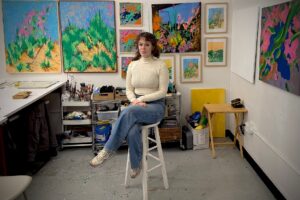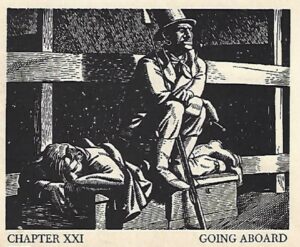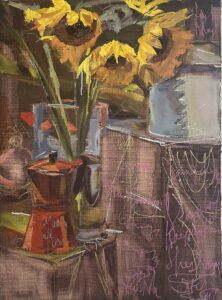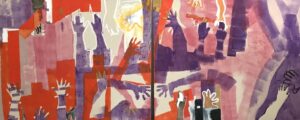Drawing Straws With Reilly Leonard
“Draw Straws,” the title of an exhibition of new work by Reilly Leonard currently at Spiritus Pizza (190 Commercial St., Provincetown), refers to the marks the artist makes to depict the grasses and stems in her paintings, which she says attempt to convey “the internalized yearning for a utopic stasis of peace.”

Leonard began the series last June during a dune shack residency. From the porch of her shack, she observed the sun setting beyond narrow paths through the hills — a view she depicts in Straw #16. For the last four months, she has been working in her new studio space at the Provincetown Commons, painting from sketches she made in the shacks.

Leonard uses a variety of media in her work, including paint marker, oil pastels, and spray paint. The paintings are done on boards, which she cuts with a jigsaw, and canvas, which she stretches herself. Sometimes she uses construction dropcloth, which gives the paintings a coarser texture. Her work involves a layering process in which she waits for each layer to dry while planning her next series of mark making.
In Straw #22, Leonard paints the pink moon as if it’s rolling down the side of a dune. The sky is washed in pink and blue, and the tips of neon green beach grasses assume extraterrestrial shapes as if they’re antennae catching signals from space.

Leonard graduated from the Rhode Island School of Design in 2020 and moved in 2021 to Provincetown, where she works night shifts at Spiritus. When she was growing up in Shelton, Conn., she worked in a seasonal haunted house where she did gore make-up and made masks for the performers. She has been making molds for frightening masks ever since and also makes life casts for plaster masks of friends and community members in her studio.
The show is on view through May 3. See @spiritus_pizza on Instagram for information. —Pat Kearns
Wrestling the White Whale
No one ever claimed Moby-Dick was an easy read. Nathaniel Philbrick used the question Why Read Moby-Dick? as the title of his book-length guide to Herman Melville’s epic novel — and even participants in the Provincetown library’s Moby-Dick marathon have been known to ask the question. This year’s marathon runs from Friday, April 25 through Sunday, April 27, starting at 10 a.m. each day and going till 5 p.m. on Friday and Sunday and 10 p.m. on Saturday.

Charles Shaw, who teaches at Boston College High School and is currently on sabbatical in Provincetown, led a Moby-Dick reading group at the library this spring. He believes the 635-page tome deserves its place in the American literary canon precisely because it is as vast and at times inscrutable as the seas where its most dramatic scenes occur.
“There’s theology in it and biology, social science,” Shaw says of the novel, which was published in 1851. “I think people have so many ways to tap into it, as well as it just being this great narrative, beautifully written.”
Moby-Dick chronicles the final voyage of the whaling vessel Pequod, commanded by Captain Ahab, who descends into madness while searching obsessively for a white whale that attacked him on a previous voyage, resulting in the loss of his leg. Some scholars believe Melville, writing in the years before the Civil War, used the Pequod as a symbolic ship of state. Throughout American history, says Shaw, readers have projected their own meanings onto the book and its characters.
“In the 1940s, Ahab was Hitler; in the Cold War, Ahab was compared to communism,” he says. “George Bush was compared to Ahab because of his search for weapons of mass destruction. You can imagine what people are doing nowadays with it. People see in the novel ways to understand their own political moment.”
Shaw’s reading group debated the book’s contemporary relevance — “Why are we reading about a dead white guy?” and “Why are there no women?” were among the questions — but was eventually won over by its language.
“I really appreciated that right away people picked up on this amazing vocabulary and amazing syntax and sentence structure,” Shaw says. “From a literary point of view, it’s so rich.”
See provincetownlibrary.org for more information about the marathon. —Katy Abel
Mozart’s Musical Comedy Classic
The Metropolitan Opera: Live in HD series continues at Wellfleet Harbor Actors Theater (2357 Rt. 6) with a simulcast of Wolfgang Amadeus Mozart’s Le Nozze di Figaro on Saturday, April 26, at 1 p.m. Sung in Italian, the opera is a “profoundly humane comedy,” according to the Met’s production notes.

When Le Nozze di Figaro premiered in Vienna in 1786, the audience may have breathed a sigh of relief — or disappointment. The opera was adapted from a play of the same name by French playwright Pierre Beaumarchais that had caused a scandal only a couple of years before. While the revolutionary play didn’t shy from social satire, Mozart and his librettist, Lorenzo Da Ponte, opted for a tamer approach, focusing on timeless emotional issues.
The plot follows servants Figaro and Susanna as they attempt to get married despite the efforts of their employer, Count Almaviva, to seduce Susanna. While the original opera is set in Seville, Spain, in the 18th century, the Met production is set in the 1930s. The musical landscape is classic Mozart: buoyant, vibrant, and thrilling.
The cast includes bass-baritone Michael Sumuel as the titular Figaro; soprano Olga Kulchynska as his betrothed, Susanna; baritone Joshua Hopkins as the Count; soprano Federica Lombardi as the Countess; and mezzo-soprano Sun-Ly Pierce as the page Cherubino. Conductor Joana Mallwitz will make her Met debut for Mozart’s renowned opera buffa.
Tickets are $15 to $27 at what.org. —Eve Samaha
Women Artists Having Their Say

Playwright and director Margaret Van Sant was intrigued by 20th-century art patron Mabel Dodge Luhan (1879-1962), who helped organize the Provincetown Players and later founded a literary and art colony in Taos, N.Mex. Research led Van Sant to Luhan’s former home in Taos and to her archived papers at Yale University.
In a library at Yale, Van Sant found a portrait of Luhan hung between paintings of writers Gertrude Stein and Alice B. Toklas, who were longtime lovers and art collectors. Van Sant knew they’d had “tempestuous” friendships with Luhan, who had hosted salons of the era’s cultural luminaries in Greenwich Village and Taos, while Stein and Toklas did the same in Paris.

“My first thought was, ‘They don’t know these women,’ ” says Van Sant. “Stein and Toklas would have hated being separated by Mabel.”

That inspired Van Sant to write Portraiture, in which the paintings come alive and continue century-old debates. The play will premiere at two Cape Cod art venues this week in a production by the Harwich-based Helltown Players.

Portraiture will be the first play ever produced in Cape Cod Museum of Art’s auditorium. It will be presented alongside the current CCMoA exhibition, She Said, which celebrates women artists from its permanent collection. The play will then move to Cotuit Center for the Arts, which has a two-floor art gallery.

Portraiture explores how historical figures are remembered and how women once ran salons that changed the art world. Stein (played by Kathleen Larson Day), Toklas (Karen McPherson), and Luhan (Anna Botsford) move in and out of frames on the stage as they talk to each other and to tour guide Sylvia Santos (Kristin Stewart). A recent rewrite turned Sylvia into a federal art historian fired by DOGE staffing cuts.
The Past Meets the Present
“Springing Forward,” the title of a new show at Berta Walker Gallery, refers not only to the time of year, but also to the 18 Outer Cape Art Collective artists whose work is in the exhibition. All members of the collective had careers in other areas before turning to art during the pandemic. Led by artist and Berta Walker Gallery assistant Laura Shabott, the group met over Zoom for three years, creating a community and expanding their forms of personal expression.

Now, many of the Collective members work full-time as artists. “This feels like yet another expansion of the Provincetown art colony, which took hold with Charles Hawthorne in the late 1890s,” says Walker. Much like those of earlier generations, the artists in the Collective support each other as they try new things.
The gallery emphasizes the connection between the early days of the Provincetown art colony and this current iteration. The front part of the gallery space is hung with lively, colorful work, including acrylic, oil, mixed-media, charcoal, and ceramic pieces. The work demonstrates a willingness to explore while also acknowledging and, in many ways, paying homage to the origins of Provincetown as an art colony.
A large painting by Laura Shabott titled Future Perfect welcomes visitors when they first enter. Abstracted arms in reds, pinks, and purples reach out to each other and to the viewer, a visual representation of the Collective and perhaps a hopeful call for the continuation of its practice.

Displayed in the back of the gallery is a smaller show titled “Provincetown Masters,” which includes works by an older generation of artists including Charles Hawthorne, Oliver Chaffee, Lucy L’Engle, Agnes Weinrich, and Hans Hofmann.

Subject more than style connects the two groups. A mixed-media piece on paper by Collective artist Dee Shippelhute titled Friends depicts whimsical animals in fantastical colors. This whimsy is repeated in a series of watercolors by Chaffee and a watercolor by L’Engle titled Swimming With Dolphins. Two still life paintings by Sondra Weiner depict vases of flowers. Abstracted surroundings and loose line work done with oil pen and charcoal distinguish these contemporary pieces from their historical counterparts, including a more traditionally imagined flower vase in oil by historical artist Helen Sawyer.

“Springing Forward” runs through May 10 at Berta Walker Gallery (208 Bradford St., Provincetown). See bertawalkergallery.com for information. —Antonia DaSilva



